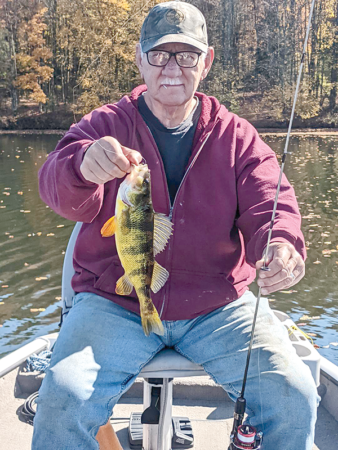This past week, my brother, Dave, and I hit an area lake, hoping to pick up some good perch. The lake we were fishing in isn’t known for large numbers of perch, but it does occasionally give up a few good-sized perch. Shortly after leaving the launch, Dave’s white jig and grub combination picked up a nice yellow perch over the thirteen-inch mark. The remainder of the afternoon yielded several decent pickerel but no more big perch, which is typical for that lake.
Perch can actually be taken the year around and even in the dead of winter. In fact, yellow perch are often a prime target for us ice fishermen since they can be active feeders through the winter months, and they are at the top of the fish dinner list. Yellow perch are, of course, in the perch family, but so are walleyes, and for those of us who like eating freshwater fish, the perch family probably tops the list. Perch are easy to fillet, and with the skin removed, the firm white fillet rolled in eggs, seasoned bread crumbs, and fried in butter is hard to beat.
Although perch can be taken the year around, you still have to find them, which can sometimes be challenging. Generally speaking, perch are mostly a deeper water fish, and unlike bluegills, you’re not likely to see them in a foot or two of water. In April or early May, perch will move into protected bays in water 5-12 feet to spawn. They prefer sand, gravel, and rock bottoms with some scattered weeds or brush. For the most part, after spawning, perch will pretty much be found in the deeper water; deep in our local lakes would mean in the 15 to 25-foot depths. In the fall, perch may move shallower around rocky shorelines, but the bigger perch will often be separated from the smaller perch and move to deeper water. In larger lakes like Lake Erie, perch may spawn deeper. Lake Erie also has a reputation for producing much larger perch and greater numbers. A thirteen-inch perch in our local lakes is a real treat since most perch will run in the 7-12-inch range, but that’s pretty normal in Lake Erie.
Our usual perch fishing technique is using an ultralight open-faced spinning outfit with a six-pound test line. A small sixteenth-ounce lead head jig with a 1-2 inch soft plastic grub is usually the lure of choice. Keeping a tight line after the cast is important to feel any hits and be ready to set the hook. Something else that often works is to troll slowly with the lure deep enough to pick up schooling fish. What color lure or grub? That’s always up for grabs; sometimes white is the top choice, but we have also done well with brown, chartreuse, yellow, purple, gold, and combinations of colors. I like to use grubs or small tubes with reflective flecks mixed in with any given color. Certainly, live bait like worms and live minnows will also work. Keep your presentations on the small side since perch have relatively small mouths and can’t open wide enough to grab large presentations. If you are fishing deeper water and prefer using a bobber to detect strikes, you may want to utilize the slip bobber technique, which allows you to select the depth to where you want to stop the bobber.
Not only can catching perch make for an enjoyable outing, but serving baked or fried fillets adds even more enjoyment.




